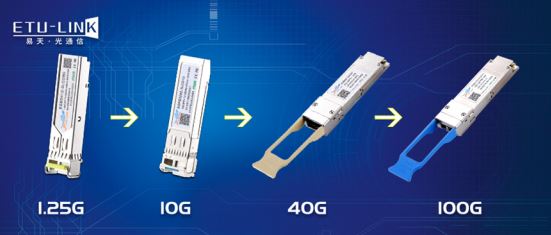
The development history of optical modules
Communication has existed since the primitive society. Beacon fires and flying pigeons were common communication methods in ancient times. Later, after the industrial revolution, telegraph and telephone appeared. Until the modern optical network, communication technology has been developing continuously. However, the three basic elements to complete the information transmission, namely the source, the channel and the information sink, that is, the transmission, transmission and reception of information, these three points are indispensable, and all the development of technology is realized around these three points.
Next, ETU-LINK will introduce the development process of optical modules to you.
When communication enters the stage of applying modern science and technology, firstly, electricity is the research object, and the quality of communication is improved from the characteristics of electricity.From the early fixed telephone, to 2G, 3G wireless communication is basically based on electricity.In recent years, people often hear "optical advance and copper retreat", which refers to the fact that the cable itself cannot achieve long-distance transmission of high-speed signals due to the characteristics of the medium itself, which limits its further development.When using electricity to transmit signals, as the transmission distance increases, the higher the frequency, the greater the loss, and the more severe the signal deformation, which causes the receiver to make an error in judgment, resulting in communication failure.
In order to overcome this limitation, the optical module converts the electrical signal into an optical signal at the transmitting end, which is what we call a transmitter, which is responsible for converting the electrical signal generated by the device into an optical signal for sending; The signal is converted into an electrical signal, which is the receiver.If the transmitter and receiver are made in one package module, it becomes an integrated transceiver module, which can both transmit and receive. This is how the optical module was born.The transmission rate of the early optical modules is from 155Mb/s at the beginning, to 622Mb/s, 1.25Gb/s, 2.5Gb/s all the way to 10Gb/s, 40Gb/s, 100Gb/s, 200Gb/s, 400Gb/s .Among them, 40G, 100G, 200G, and 400G optical modules use parallel transmission, for example, 40G QSFP+ SR4/LR4/ER4.

For short-distance transmission, some optical fibers used in parallel transmission do not make much difference in material and construction costs.But, for long-distance communication, the construction cost of laying an optical cable is far greater than the material itself. In long-distance transmission, TDM time division multiplexing will be limited by the switching frequency of electronic devices, so one optical fiber is used to transmit multiple wavelengths. The technology was born, we call it WDM, and there are two common types of WDM, namely CWDM (coarse wavelength division multiplexing) with 20nm spacing and DWDM (dense wavelength division multiplexing) with 0.8nm spacing. WDM optical modules are mainly used in the transmission of backbone networks and metropolitan area networks, while multi-mode optical modules for short-distance transmission are mainly used in data centers and enterprise networks.
In the field of data communication, the application of silicon photonics integration technology in high-speed optical modules has received extensive attention. Its advantages lie in high integration and low power consumption, which can meet the data center's demand for small size and low power consumption of optical modules.
Categories
New Blog
Tags
© Copyright: 2025 ETU-Link Technology CO ., LTD All Rights Reserved.

IPv6 network supported
Friendly Links:
易天官网